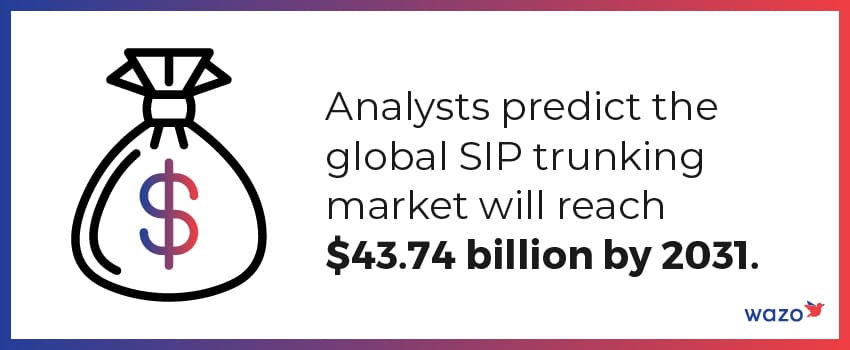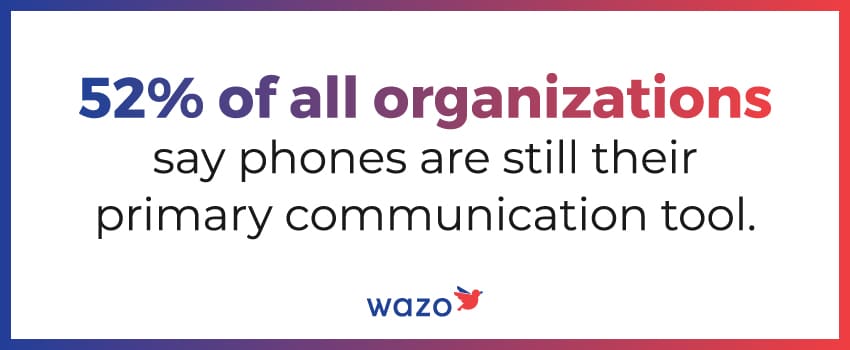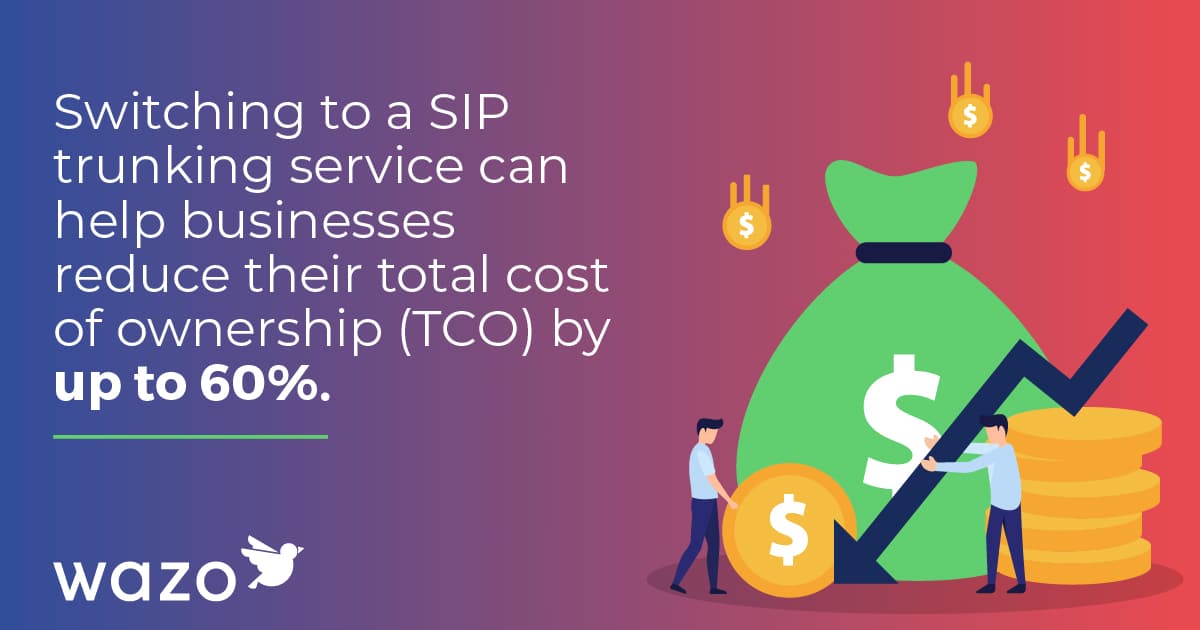Businesses today have plenty of communication channels to connect their employees and consumers, but voice calls still reign supreme. Over half (52%) of all organizations say phones are their primary communication tool,1 and 63% expect business phone use to increase over the next few years.2
But with many companies adopting remote and hybrid working models, legacy on-premises phone systems can’t keep up. On-premises PBX systems make it harder for businesses to support work-from-anywhere staff – not to mention they’re expensive to maintain and lack the flexible, cloud-based features many employees have come to rely on.
That’s where SIP trunking comes in. In this blog, we’ll discuss what SIP trunking is, who should use it, and how it can benefit your business communications.
What Is SIP Trunking?
SIP trunking, short for session initiation protocol trunking, replaces the need for traditional phone lines by transmitting voice and other unified communication services over the internet. It provisions voice over internet protocol (VoIP) technology to connect a company’s on-premise phone system with the public switched telephone network (PSTN) using a virtual trunk, which acts as a pathway for voice calls, video conferencing, instant messaging, and other real-time communication sessions.
In a nutshell, SIP trunking creates virtual phone lines that let businesses make and receive phone calls over IP PBX networks.
What Is Sip Trunking Used For?
The main purpose of SIP trunking is to replace Primary Rate Interface (PRI) technology, which companies have used to transmit voice and data over physical phone lines for decades. However, this hardware is quickly becoming outdated and expensive to maintain.
Since SIP trunking sends calls over a virtual phone line, it’s a more cost-effective solution for business communications. These lower communication costs likely play a big role in driving growth in the global SIP trunking market, which is expected to reach $43.74 billion by 2031.3
It also supports video conferencing and instant messages, making it easier for businesses to leverage multiple communication channels than a traditional phone system.
How Does Sip Trunking Work?
Traditionally, businesses relied on Integrated Services Digital Network (ISDN) circuits, which are physical copper lines installed on their premises to transmit voice and data over digital connections. SIP trunking replaces this physical infrastructure by breaking calls down into digital packets and sending them over a data network.
The primary components of SIP trunking technology include:
SIP Channels
Think of SIP channels as the digital version of analog phone lines. Each SIP channel represents a separate line through which users can transmit a voice call. Unlike physical lines, businesses can add or remove SIP channels as needed without having to adjust their infrastructure.
SIP Trunks
A SIP trunk connects a company’s voice sessions to its Internet Telephony Service Provider (ITSP), enabling employees to make internal calls over the corporate network and external calls with other phone and data networks. The SIP trunk groups multiple SIP channels, ultimately determining the number of concurrent calls the network can handle simultaneously.
SIP Protocol
Session initiation protocol is an application layer protocol that initiates and terminates voice communication sessions over the internet, allowing users to talk in real time using phone calls, video calls, or instant messaging services.
Internet Connection
SIP trunking needs an internet connection to transmit communication sessions. This can be a dedicated or shared internet service as long as it offers reliable, high-quality internet connectivity.
Internet Telephony Service Provider (ITSP)
An ITSP is a service provider that delivers communication services over IP networks. They’re the go-between for a company’s internal network and the external world, converting voice signals into data packets and routing them between endpoints.
Session Border Controller (SBC)
An SBC secures and manages SIP connections between networks. It acts as a firewall by enforcing security policies, authenticating users, and encrypting traffic to protect an organization’s internal network from potential threats.
SIP Trunking and Related Technologies
While SIP trunking shares similarities with other communication technologies, understanding how these related services differ is important for determining the best solution for your business. Here’s how SIP compares to other options:
SIP vs. VoIP
While people often use SIP and VoIP interchangeably, they aren’t the same. VoIP is an industry term that covers any phone calls made over the internet instead of a traditional phone line. SIP uses VoIP to enable voice calls but can also support services like video and messaging, making it a broader technology than VoIP.
SIP Trunking vs. PRI Trunking
SIP trunking and PRI trunking are two different methods of connecting a business communications system to the PSTN. A PRI trunk sends data over a physical connection, with each PRI circuit supporting multiple voice channels. In contrast, a SIP trunk leverages the internet to create a virtual connection for communications.

What Are the Benefits of SIP Trunking?
SIP trunking offers several benefits for businesses, regardless of size or industry. Here are the top advantages of switching to a SIP trunking service:
Cost Savings
Switching to SIP trunking services helps companies reduce their total cost of ownership (TCO) by up to 60%.4 By eliminating the need for analog phone lines, you can enjoy cost savings on long-distance calls, line rentals, and infrastructure maintenance.
SIP trunking offers simplified pricing, typically on a per-user basis, so you only pay for the maximum number of concurrent calls you expect to make. You also get to choose between metered and unmetered SIP trunk plans for more control over your communication expenses if your business experiences a lower call volume.
Reliability
Traditional phone lines can be disrupted due to issues like bad weather or damaged telephone poles. SIP trunks include number failover, meaning you can stay connected even during a system failure by routing calls to other lines, locations, or mobile devices. And because SIP trunking providers use VoIP technology, calls can take the best-available path to reach their destination to ensure uninterrupted communication.
Scalability
With a SIP trunking system, you can easily add or remove channels to scale your communications based on demand. No need to invest in new infrastructure or speak to a customer service rep just to add extra phone lines – SIP trunking lets you do that on your own.
Simplified Management
SIP trunking unifies your communication services across multiple locations into a single, centralized system. This simplified management offers more efficiency and greater control over your communication resources, especially if your business has several geographically-dispersed branch offices.
Call Quality
SIP trunks are designed to provide ample bandwidth for high-quality calls. As long as your internet connection is reliable and your PBX system isn’t overloaded, your business calls should be clear even during busy periods. Plus, new artificial intelligence technologies can automatically improve the voice quality of calls made using SIP trunks, so you won’t have to worry about static, echoes, or dropped calls.
Security
Unlike a traditional business phone system, a SIP trunking service can encrypt data to protect your enterprise communications from eavesdropping or interception. Many SIP services also offer real-time monitoring and alerting to help prevent suspicious phone calls, such as toll fraud.
Flexibility
With SIP trunking, businesses can establish a local presence in different geographic locations. They can acquire phone numbers from various regions, even if their physical location is different. This capability enables organizations to expand their customer reach, improve customer service, and enhance their market presence without having a physical presence in every region.
Advanced Features
SIP trunking supports a wide range of advanced communication features that help to enhance collaboration and productivity, including video conferencing, instant messaging, interactive voice response (IVR) systems, and integration with other business applications.

Helpful SIP Trunking Features
If you’re considering SIP trunk service for your business, finding a solution that meets your organization’s unique communication needs is key. Here are some essential SIP trunk features to look for:
Interoperability
Your SIP trunking system should be capable of operating in a variety of digital environments, just as most apps and software can run on any operating system. Interoperability is essential for businesses to seamlessly integrate their existing PBX or unified communications system with SIP trunking services without the need for major system overhauls.
Data Protection
Many SIP trunking providers offer platforms that include security features designed to protect your data, including encryption, user authentication, and firewalls. These features help safeguard business communication systems against unauthorized access and data breaches.
Automation
The best SIP trunking providers leverage automation to make system implementation, monitoring, and management easy, reducing the need for human intervention as much as possible.
Real-Time Analytics
Consider SIP trunk services that provide real-time data reporting and analytics. These features offer helpful insights into call usage, allowing businesses to monitor communication patterns and optimize resources.
Third-Party Integrations
Look for a SIP trunking provider that offers integration with your other critical business applications and platforms. Third-party integrations can enable features such as CRM integration, click-to-call functionality, and call recording to improve productivity and streamline workflows.
Build a Secure, Flexible Communications Solution With Wazo
SIP trunking enables businesses to gain more control over their communications – without compromising call quality or cost.
With Wazo, you can give your customers all the business phone system features they need to grow with our flexible, VoIP-based communications system. We leverage SIP trunking to integrate our customizable unified communications platform with your existing infrastructure, so you can take control of your data, customers, and offerings.
Over 100 partners and 5000+ customers worldwide trust us to provide the communication solutions and superior support they need to build better UCaaS experiences. Contact Wazo today to get started.
Sources:
- https://fitsmallbusiness.com/voip-stats
- https://www.ringcentral.com/us/en/blog/the-state-of-enterprise-communications
- https://www.transparencymarketresearch.com/sip-trunking-services-market.html
- https://www.einnews.com/pr_news/569391594/high-annual-growth-predicted-in-2022-and-beyond-for-sip-trunking


